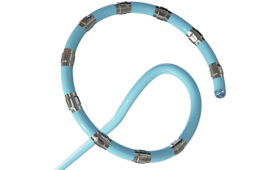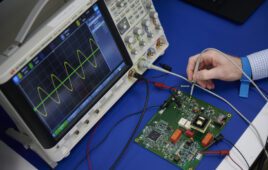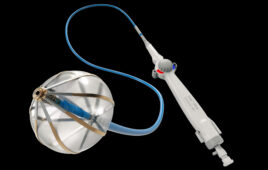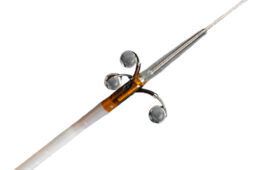The UltraNav Transseptal Catheter System houses transeptal needles and wires with the intracardiac echocardiography catheter, optimizing safety and efficacy of transseptal procedures
By Nabil Dib, Dib UltraNav Medical

The Dib UltraNav Transseptal Catheter System [Photo courtsy of Dib UltraNav Medical]
The significant rise in procedure volume presents both challenges and opportunities.
The challenges include a correlated rise in procedural complications. Even though the percentage of procedures with complications is overall very low — 1-2% of procedures involving transesophageal echo (TEE), for example, result in unintended perforations — the rapid increase in septal procedures raises the overall number of complications.
When you consider that such complications can be catastrophic for patients, you can recognize the opportunity to find a way to decrease these incidents.
Other opportunities include the chance to reduce procedure costs and enhance patient experience and convenience. The market opportunity is compelling as well, given the need for devices aiding transseptal procedures is projected to more than double between 2021 and 2025.
My team and I moved forward in 2020 to develop a new way for cardiologists to approach the heart during transseptal procedures by inventing the UltraNav Transseptal Catheter System. The device, which received FDA clearance in March 2022, was designed to meet the challenges and unlock the opportunities.
How the UltraNav system works
Traditional transseptal procedures require either the placement of an intracardiac echocardiography (ICE) catheter into the heart or a transesophageal echocardiography (TEE) imaging catheter into the esophagus to display ultrasound images that guide the transseptal puncture needle and treatment catheter during the procedure.
The ICE catheter approach involves the use of two separate systems: a sheath containing a transeptal needle and an ICE catheter emitting ultrasound beam, located on two different planes. This provides only a partial and intermittent, and thus less-than-adequate image of the orientation of the catheter and needle and depth of the needle tip relative to the cardiac structure. The TEE procedure poses a similar condition, in addition to the need for general anesthesia.
The new UltraNav catheter combines the needle and ultrasound into one system so that they can function together on the same plane. Working in one plane vs. two provides optimal visualization of needle tip to avoid perforation, and complete visualization of needle orientation relative to target tissue for optimal septal puncture. The single system also provides a continuous (instead of intermittent) image which reduces visual disruptions from the cardiac and respiratory motion of the patient during the procedure.
UltraNav’s system houses the needle and the ICE, facilitating atraumatic crossing from the right to left atrium. The device also facilitates transport of other catheters/wires from right to left with ease. General anesthesia is not required when UltraNav is used.
The UltraNav system is compatible with current needles, VersaCross RF wires, and various types of ICE catheters.
The result is more precise and continuous visualization during transseptal procedures and more precise, safer puncture of the septum. Cardiologists can see exactly where they are in the procedure, with a complete picture of the heart’s internal anatomy and the catheters and needles being used. This improves efficacy, reduces complications, and contributes to the overall success of the procedure.
First-in-human use of UltraNav
In 2023, the UltraNav lumen catheter was first used in humans during procedures at Dignity Health system in Arizona and the Mayo Clinic in Minnesota. To date, it has successfully facilitated transseptal procedures in 23 human cases.
It is proving to increase safety by reducing complications and improving patient experience by speeding recovery through the elimination of anesthesia and over-night hospital stays. These outcomes reduce costs for both hospitals and patients.
And when working with other cardiologists to present the system, I have seen a reduction in their learning curve for transseptal procedures. My team and I expect these benefits will lead to even greater acceleration and expansion of successful structural heart procedures, which is our ultimate goal: to help physicians and patients achieve more successful outcomes.

Dr. Nabil Dib and the UltraNav Transseptal Catheter System [Photo courtesy of Dib UltraNav Medical]
How to submit a contribution to MDO
The opinions expressed in this blog post are the author’s only and do not necessarily reflect those of Medical Design & Outsourcing or its employees.




